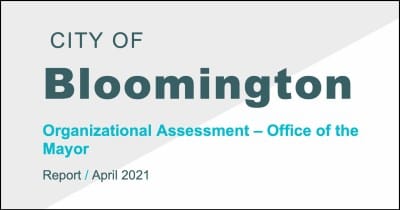Consultant: Bloomington mayor’s office should add top-level position, give better briefings to city council

In response to a records request filed by The B Square, the city of Bloomington has released a 32-page report by the Novak Consulting Group that analyzes the organizational structure of the mayor’s office.

The report was completed and delivered to the city almost a year ago, in the third week of April 2021.
Among the recommendations in Novak’s report is to add a second deputy mayor position. Another recommendation is to “expand and enhance the City Council briefing process.”
The report lists out seven recommendations in all:
- Add a Deputy Mayor position responsible for internal OOTM administration, public outreach, communications, and special projects.
- Develop an administrative strategic plan.
- Establish a formal project evaluation process within the OOTM.
- Expand and enhance the City Council briefing process.
- Define clear lines of decision-making authority regarding public engagement and communications efforts.
- Contract for the development of a strategic communications plan.
- Refocus the City’s innovation program to develop process improvement capacity within each City department.
The recommendation to add a second deputy mayor position presumably does not mean that both positions would be deputy mayor as defined under Indiana’s state statute on the organization of cities.
The state law presupposes there could be exactly one deputy mayor, and describes how the deputy mayor can fill in for the mayor under certain circumstances. The state law also requires that the city council establish an ordinance to create the position of deputy mayor, which Bloomington’s city council did in 1984.
The Novak Group did not respond to an emailed question from The B Square on the status of the recommended additional deputy mayor in the contest of state law.
Based on the description in the report, the second deputy mayor position could be called the “chief of staff” or have some other job title: “This position can effectively serve as a chief of staff and provide capacity for the other deputy mayor to focus on operations.”
Underlying the recommendation to add a second position at the deputy mayor level is the relatively large number of positions that now report directly to the deputy mayor. The Novak report pegs that number at 18, which “significantly exceeds benchmark norms for supervisory spans of control,” according to the report.
Whatever the job title might be, the second deputy mayor would supervise other positions within the mayor’s office: communications director; the director of public engagement; and the director of innovation. The only external department head who would report to the second deputy mayor would be the director of economic and sustainable development.
According to the Novak report, the mayor’s office has doubled its number of staff, from four to eight, since 2016, which is the year current mayor John Hamilton took office.
Here’s what the org chart for the mayor’s office would look like if a second deputy mayor position were added:

The Novak report’s recommendation to beef up the informational briefings to the city council was based on interviews with all members of the city council, according to the report.
The interviews with city councilmembers included two main themes: a desire by councilmembers for more direct involvement in the development of city policy; and more “intentional communication” between the mayor and the city council.
According to the report, more city council involvement in the development of policy could in part be addressed by the recommendation that is numbered (2) in the list: Develop an administrative strategic plan. The idea is to integrate the city council into the strategic planning process “while maintaining the autonomy of the OOTM [office of the mayor].”
According to the report, more intentional communication could be addressed in part by the recommendation that is numbered (6) on the list: Contract for the development of a strategic communications plan. The strategic communications plan would establish “clear requirements and expectations regarding city communications, including those between the executive branch and the governing body.”
But recommendations (2) and (6) don’t cover the specific issues addressed in recommendation (4): Expand and enhance the City Council briefing process.
The specific recommendation in (4) is supposed to address the council’s desire for more “consistent and targeted communication regarding City programs and initiatives, especially when they will potentially result in questions from the public or news organizations.”
Existing mechanisms for communication from the administration to the city council include the bi-weekly briefings of city council officers and briefings provided at city council meetings.
The recommendation is to add some kind of systematic briefing of the city council by the administration, when the mayor’s office can update the city council about various activities within the city. The recommendation is for the additional briefing to be led by the communications manager using part-time interns for support.
Novak’s organizational assessment of the mayor’s office was part of the same $38,900 project that produced a report on the organization of the city’s boards and commissions. The Novak report on board and commissions was presented to the city council in early February.




Comments ()